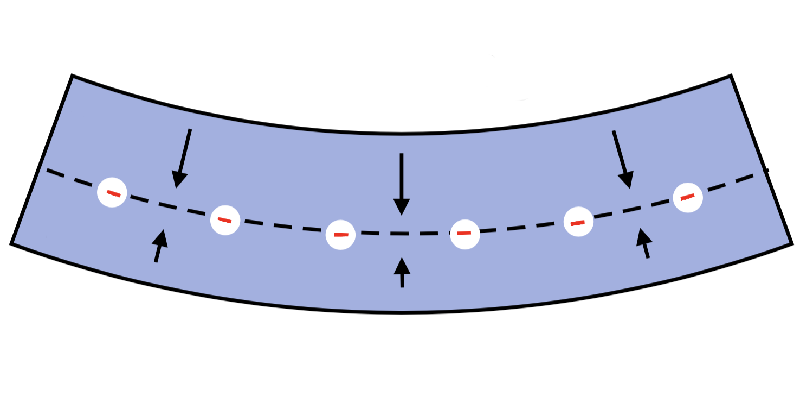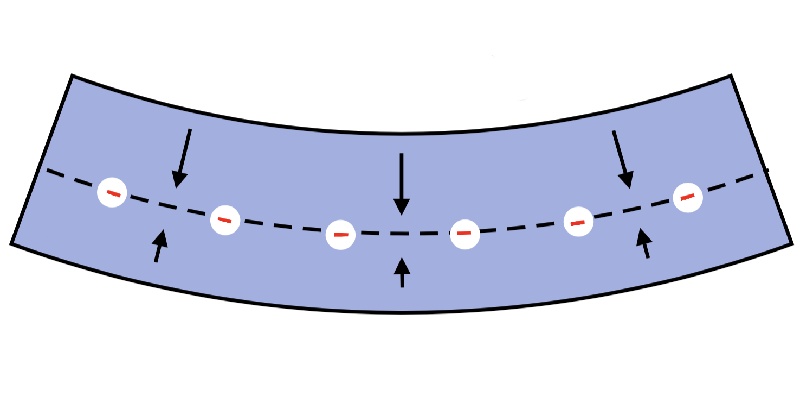More Voltage from Bending Silicone Rubber
Flexoelectric materials generate a voltage when bent, a property that could be useful in engineering delicate sensors or energy harvesting devices, such as clothes that would produce electricity when a person walks. Researchers have now shown that adding a layer of charge to the middle of a flexible polymer bar can boost the effect by 100 times. The team says that with further development, the effect could be used in real devices within five years.
Many ordinary materials such as crystals and polymers exhibit the flexoelectric effect. Bending the material causes each atomic layer to be stretched by a different amount, with the outermost layer stretched the most. This variation in stretch (a strain gradient) can create asymmetry in the positions of the material’s ions and can prevent the positive and negative charges from completely canceling, or, in other words, the material can become polarized. The polarization leads to a net electric field and thus a voltage.
Ceramics show the strongest effect, reflected in a high flexoelectric coefficient—a parameter indicating how much voltage is generated for a given bend. However, ceramics are brittle and can break from even small deformations. So researchers attempting to exploit the effect in practical devices have mostly focused on films of nanoscale thickness, which are easier to bend than thicker samples.
To produce the effect in macroscopic samples, one can use more flexible materials such as polymers, although their intrinsic flexoelectric effect is small. But now a team of researchers from Xi'an Jiaotong University in China has shown how to boost the effect in a polymer bar, merely by embedding a layer of permanent electric charge within the polymer.
Team leader Qian Deng and his colleagues experimented with a 10-cm-long bar of polydimethylsiloxane (PDMS, a type of silicone rubber) with width 15 mm and thickness 10 mm. The team embedded a thin layer of negatively charged polymer into the central plane along the length of the bar. This charge layer produced an electric field that created a voltage at the surfaces above and below the central plane.
The researchers then measured the flexoelectric coefficient for different amounts of embedded charge. In each measurement, with the bar horizontal, supported at each end, they applied a controlled downward force at the center, to deform the bar, and then measured the change in voltage registered at the surface.
The flexoelectric coefficient grew in direct proportion to the embedded charge. With charge sufficient to generate 5 kV on the polymer surface, the coefficient was 100 times larger than for PDMS without any embedded charge. The technique works, the researchers argue, because the parallel, vertical field lines emanating from the charge layer become splayed when the bar is bent. The lines spread out below the central plane and are compressed above it. This asymmetry leads to a strong polarization, measurable as a voltage across the bar, from bottom to top. The experimental results agreed closely with the team’s calculations.
“The basic idea is that the charge creates an initial electric field in the material, symmetric on the two sides,” Deng says. “Bending breaks this symmetry, so there's a net electric polarization across the film.”
“The effect the authors are seeing is substantial,” says nanoscience expert Gustau Catalán of the Catalan Institute of Nanoscience and Nanotechnology in Barcelona, Spain. He thinks the results could have broad implications. “This work has an appeal that goes beyond the flexoelectric community, and it could stimulate the search for similar effects in systems where, a priori, one would not have looked for flexoelectricity.”
Deng and colleagues believe the effect will find use in practical devices fairly soon. Although, according to team member Xin Wen, a key challenge will be learning how to prevent the loss of the embedded charge in the film, as it tends to slowly leak out.
As for commercial uses, Wen expects practical devices “in the next five years,” assuming input from a range of experts in the development process. He suggests that the effect will be useful in building devices such as sensors, energy harvesters, and actuators.
This research is published in Physical Review Letters.
–Mark Buchanan
Mark Buchanan is a freelance science writer who splits his time between Abergavenny, UK, and Notre Dame de Courson, France.





